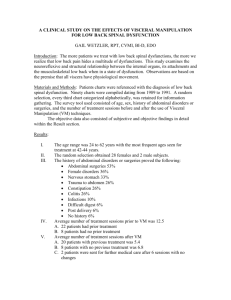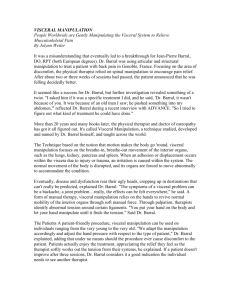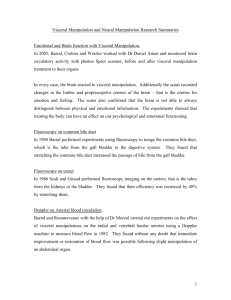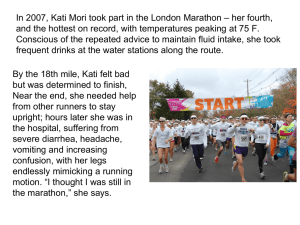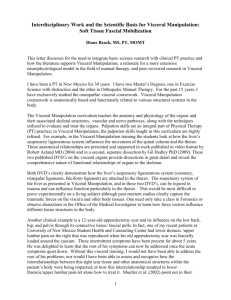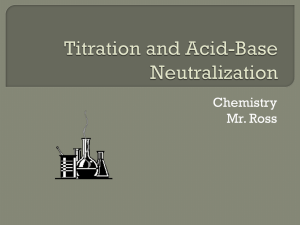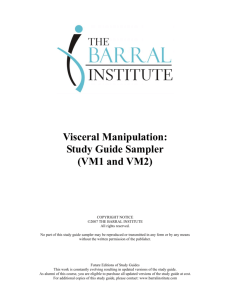Introducing Visceral Manipulation for Pediatrics
advertisement
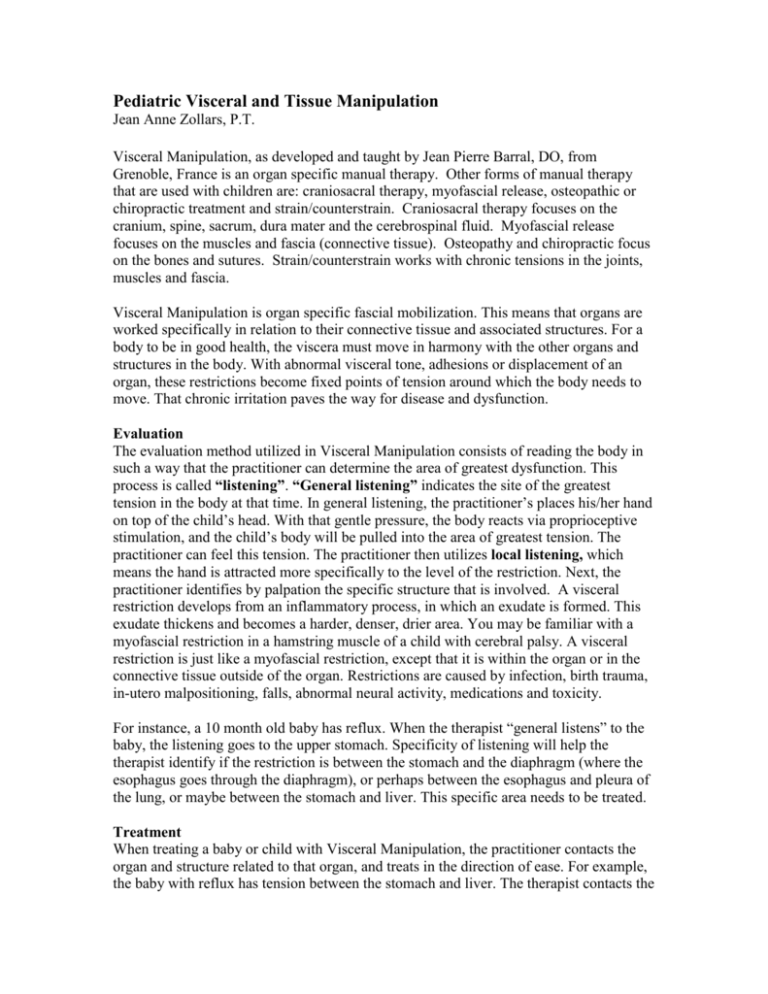
Pediatric Visceral and Tissue Manipulation Jean Anne Zollars, P.T. Visceral Manipulation, as developed and taught by Jean Pierre Barral, DO, from Grenoble, France is an organ specific manual therapy. Other forms of manual therapy that are used with children are: craniosacral therapy, myofascial release, osteopathic or chiropractic treatment and strain/counterstrain. Craniosacral therapy focuses on the cranium, spine, sacrum, dura mater and the cerebrospinal fluid. Myofascial release focuses on the muscles and fascia (connective tissue). Osteopathy and chiropractic focus on the bones and sutures. Strain/counterstrain works with chronic tensions in the joints, muscles and fascia. Visceral Manipulation is organ specific fascial mobilization. This means that organs are worked specifically in relation to their connective tissue and associated structures. For a body to be in good health, the viscera must move in harmony with the other organs and structures in the body. With abnormal visceral tone, adhesions or displacement of an organ, these restrictions become fixed points of tension around which the body needs to move. That chronic irritation paves the way for disease and dysfunction. Evaluation The evaluation method utilized in Visceral Manipulation consists of reading the body in such a way that the practitioner can determine the area of greatest dysfunction. This process is called “listening”. “General listening” indicates the site of the greatest tension in the body at that time. In general listening, the practitioner’s places his/her hand on top of the child’s head. With that gentle pressure, the body reacts via proprioceptive stimulation, and the child’s body will be pulled into the area of greatest tension. The practitioner can feel this tension. The practitioner then utilizes local listening, which means the hand is attracted more specifically to the level of the restriction. Next, the practitioner identifies by palpation the specific structure that is involved. A visceral restriction develops from an inflammatory process, in which an exudate is formed. This exudate thickens and becomes a harder, denser, drier area. You may be familiar with a myofascial restriction in a hamstring muscle of a child with cerebral palsy. A visceral restriction is just like a myofascial restriction, except that it is within the organ or in the connective tissue outside of the organ. Restrictions are caused by infection, birth trauma, in-utero malpositioning, falls, abnormal neural activity, medications and toxicity. For instance, a 10 month old baby has reflux. When the therapist “general listens” to the baby, the listening goes to the upper stomach. Specificity of listening will help the therapist identify if the restriction is between the stomach and the diaphragm (where the esophagus goes through the diaphragm), or perhaps between the esophagus and pleura of the lung, or maybe between the stomach and liver. This specific area needs to be treated. Treatment When treating a baby or child with Visceral Manipulation, the practitioner contacts the organ and structure related to that organ, and treats in the direction of ease. For example, the baby with reflux has tension between the stomach and liver. The therapist contacts the lesser curvature of the stomach with one hand, the left lobe of the liver with the other hand. By contacting these two organs, the organs will start a “listening”, a movement into the direction of ease. In this case, the stomach and liver will pull towards each other until a tissue release is palpated. A release feels like a softening of the tissue. The restriction is freed so that the stomach and liver slide and glide on each other. After the area is treated, the next step is to re-listen to the body. Perhaps the listening takes you to the left occipitomastoid suture – the suture between the temporal and occipital bones. Now if we look at our anatomy, we see that the vagus nerve exits in the jugular foramen between these two bones. We may even feel a “line of tension” between the occipitomastoid suture and the upper stomach. This would make sense anatomically because of the pathway of the esophagus and vagus nerve as they both travel through the thorax. Thus, when we “line up the tension”, or engage the two structures between our hands so that we can feel a specific tension, we may release these structures and thus help the child with their symptom of reflux. Mobility of Organs Another example….an irritable baby with developmental delays came into my office with full body eczema and allergies to almost every food. The listening took me to the common bile duct. The common bile duct is the tube that dumps bile from the liver and gallbladder into the duodenum. Bile is very important for the breakdown of fats. Because of the tension in this area, not only was the bile duct restricted, but the duodenum and liver were restricted. Another important concept in Visceral Manipulation is organs need to move in order to work properly. The ability for organs to move as we are moving our bodies, as we breathe, as the heart pumps, as fluids move through the body is called mobility. For this little girl, the liver, duodenum, and bile duct were not moving, so the fats and proteins could not be digested. If food cannot be digested and metabolized, growth and development will be affected. The release of the common bile duct took less than thirty seconds. Her liver and duodenum freed up and the eczema cleared. For a child like this it is also important to look at diet and other disciplines like homeopathy. However, Visceral Manipulation made a significant change in her digestion. She began to grow and became a happy child. Her gross motor skills and speech skills improved so that now, at the age of 3, she has no more delays. What happens physiologically when a visceral restriction is released? When a visceral restriction is released more arterial or venous blood flows in that area allowing the collagen fibers to become more elongated and hydrated. Tissue metabolism improves. A stomach, for instance, has both mechanical and chemical functions. Chemically, it produces acidic gastric juices to break down the food. Mechanically, it has three layers of muscles that work together to churn up the food. We breathe 24,000 times per day. Each time we breathe, the stomach needs to move inferiorly, anteriorly and in medial rotation. The upper esophagus laterally rotates with the left lung. The twisting helps to create the cardiac sphincter which opens to let food go into the stomach and closes to prevent stomach acids refluxing into the esophagus. For good digestion, mobility is essential so that food contents have optimal contact with the gastric mucosa. If the upper stomach is pulled superiorly and does not has a chance to move fully, the stomach contents do not completely contact the gastric mucosa for optimal digestion. Mechanical problems affect chemical digestion. Visceral Manipulation in Children with Neuromotor Problems Just as myofascial release can assist a child with cerebral palsy and spastic diplegia gain increased length in the hamstrings, Visceral Manipulation can free up deeper tissue restrictions to allow for more mobility and function. For instance, suppose a child had a lung infection in the right upper lobe of the lung in the first few months of life. The area of the infection created scar tissue, so such that the upper lobe of the right lung became denser, tighter, and drier. The lung is covered with pleura, so the pleura became tight. The pleural dome is directly connected into the cervical and thoracic spine (C6, C7, T1) and first rib via the transverse pleural, pleurovertebral, and costopleural ligaments. This lung tension is translated into the cervical spine, which of course will also pull on the brachial plexus into the right shoulder. Move forward a number of years. This child is now five years old with cerebral palsy and spastic quadriplegia. She tends to internally rotate her shoulders, right more than left and has a lack of stability in the upper thoracic and lower cervical area. Her thorax is rounded forward and tight. The therapist has worked on the pectoralis major and latissimus dorsi with myofascial release and worked to gain stability and control of the upper thoracic area and shoulder girdles. However, the upper thorax is still rounded forward and very tight. If the lung, pleural and rib restrictions are released, the child will gain more thoracic extension, so that the muscles will have a greater ability to stabilize the thorax and move the neck and shoulders. Just as in any mobilizations, visceral and tissue manipulations need to be followed up by neurodevelopmental treatment. Specificity The big difference between the work of Jean-Pierre Barral and other manual therapies is that listening is the first evaluative tool that takes us to the part of the body that is having the most difficulty, thus where the practitioner must treat. Secondly, that area is treated with specificity. When we treat a baby or child, we must be very specific. If we treat a general area, the results are general. If we treat a very specific structure, like a specific nerve or specific branch of the bronchi – the brain receives this information via the nocioceptive system and makes a specific change in the brain and thus in the entire body. Typical Pediatric Referrals Babies and children with a variety of diagnoses and problems may be seen by a visceral practitioner. Some common problems are: reflux, colic, torticollis, plagiocepahly, allergies, constipation, digestive problems, thoracic and neck injuries. Visceral Manipulation is also indicated for children with neurodevelopmental problems, prematurity and autism. Pediatric Tissue Manipulation Many types of tissues may be involved and need to be treated in babies and children. For the craniosacral system, Jean-Pierre Barral teaches how to differentiate and treat various layers of restrictions, i.e. bones, sutures, and dura mater. He also teaches how to treat the peripheral nerves of the upper and lower extremities, as well as nerve plexi. Barral also incorporates working with the cranial nerves, brain and emotions. Future work and teaching of Barral include working with the vascular system and the soft tissue components of joints. Techniques are always chosen for a child depending on the specific listening techniques. Movement is life. In order for the children we treat to become as healthy as possible, restricted areas of the body need to be freed, so that their bodies can be integrated and whole. Jean Anne Zollars, MA, PT has worked 26 years as a physical therapist, 25 years with children. She became certified in NDT pediatrics in 1988 with Judi Bierman, She is the author of Special Seating: An Illustrated Guide. She began studying Visceral Manipulation in 1992 and started teaching Visceral Manipulation in 2004. Jean Anne and Gail Wetzler, PT will be teaching “Visceral Manipulation: Application for Pediatrics” through the Barral Institute.
